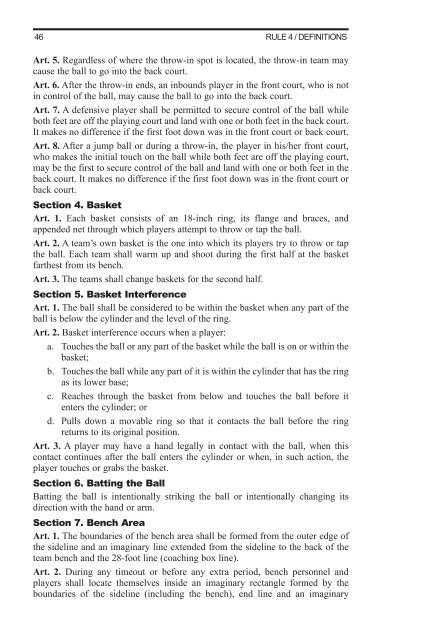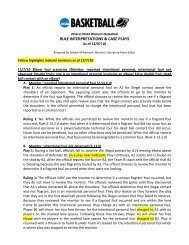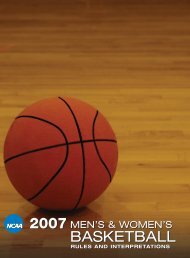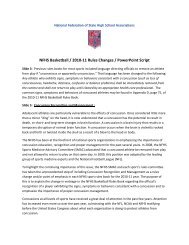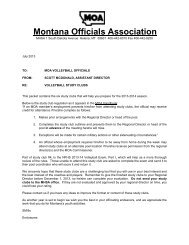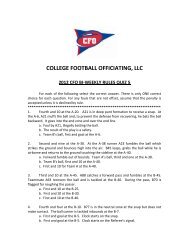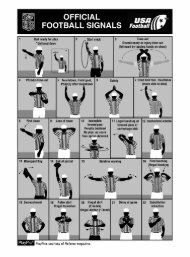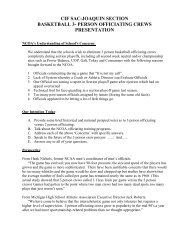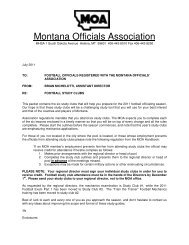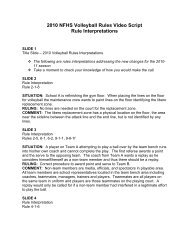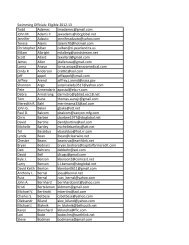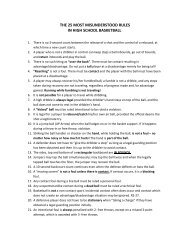2011-12 AND 2012-13 MEN'S AND WOMEN'S RULES - NAIA
2011-12 AND 2012-13 MEN'S AND WOMEN'S RULES - NAIA
2011-12 AND 2012-13 MEN'S AND WOMEN'S RULES - NAIA
Create successful ePaper yourself
Turn your PDF publications into a flip-book with our unique Google optimized e-Paper software.
46<br />
RULE 4 / DEFINITIONS<br />
Art. 5. Regardless of where the throw-in spot is located, the throw-in team may<br />
cause the ball to go into the back court.<br />
Art. 6. After the throw-in ends, an inbounds player in the front court, who is not<br />
in control of the ball, may cause the ball to go into the back court.<br />
Art. 7. A defensive player shall be permitted to secure control of the ball while<br />
both feet are off the playing court and land with one or both feet in the back court.<br />
It makes no difference if the first foot down was in the front court or back court.<br />
Art. 8. After a jump ball or during a throw-in, the player in his/her front court,<br />
who makes the initial touch on the ball while both feet are off the playing court,<br />
may be the first to secure control of the ball and land with one or both feet in the<br />
back court. It makes no difference if the first foot down was in the front court or<br />
back court.<br />
Section 4. Basket<br />
Art. 1. Each basket consists of an 18-inch ring, its flange and braces, and<br />
appended net through which players attempt to throw or tap the ball.<br />
Art. 2. A team’s own basket is the one into which its players try to throw or tap<br />
the ball. Each team shall warm up and shoot during the first half at the basket<br />
farthest from its bench.<br />
Art. 3. The teams shall change baskets for the second half.<br />
Section 5. Basket Interference<br />
Art. 1. The ball shall be considered to be within the basket when any part of the<br />
ball is below the cylinder and the level of the ring.<br />
Art. 2. Basket interference occurs when a player:<br />
a. Touches the ball or any part of the basket while the ball is on or within the<br />
basket;<br />
b. Touches the ball while any part of it is within the cylinder that has the ring<br />
as its lower base;<br />
c. Reaches through the basket from below and touches the ball before it<br />
enters the cylinder; or<br />
d. Pulls down a movable ring so that it contacts the ball before the ring<br />
returns to its original position.<br />
Art. 3. A player may have a hand legally in contact with the ball, when this<br />
contact continues after the ball enters the cylinder or when, in such action, the<br />
player touches or grabs the basket.<br />
Section 6. Batting the Ball<br />
Batting the ball is intentionally striking the ball or intentionally changing its<br />
direction with the hand or arm.<br />
Section 7. Bench Area<br />
Art. 1. The boundaries of the bench area shall be formed from the outer edge of<br />
the sideline and an imaginary line extended from the sideline to the back of the<br />
team bench and the 28-foot line (coaching box line).<br />
Art. 2. During any timeout or before any extra period, bench personnel and<br />
players shall locate themselves inside an imaginary rectangle formed by the<br />
boundaries of the sideline (including the bench), end line and an imaginary


